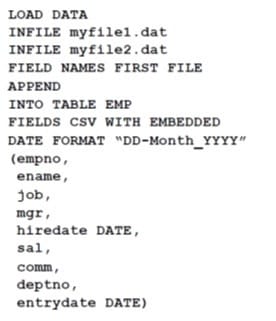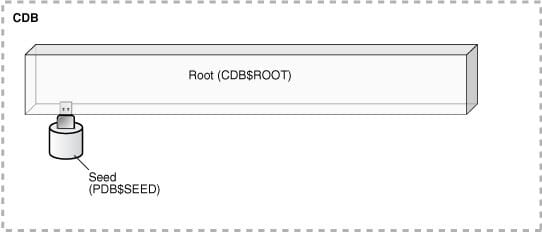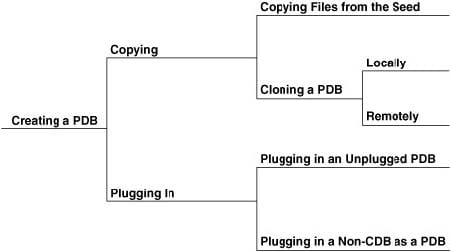Exam Details
Exam Code
:1Z0-062Exam Name
:Oracle Database 12c: Installation and AdministrationCertification
:Oracle CertificationsVendor
:OracleTotal Questions
:411 Q&AsLast Updated
:Dec 24, 2024
Oracle Oracle Certifications 1Z0-062 Questions & Answers
-
Question 341:
Which two statements are true concerning the Resource Manager plans for individual pluggable databases (PDB plans) in a multitenant container database (CDB)? (Choose two.)
A. If no PDB plan is enabled for a pluggable database, then all sessions for that PDB are treated to an equal degree of the resource share of that PDB.
B. In a PDB plan, subplans may be used with up to eight consumer groups.
C. If a PDB plan is enabled for a pluggable database, then resources are allocated to consumer groups across all PDBs in the CDB.
D. If no PDB plan is enabled for a pluggable database, then the PDB share in the CDB plan is dynamically calculated.
E. If a PDB plan is enabled for a pluggable database, then resources are allocated to consumer groups based on the shares provided to the PDB in the CDB plan and the shares provided to the consumer groups in the PDB plan.
-
Question 342:
In your multitenant container database (CDB) containing pluggable database (PDBs), you granted the CREATE TABLE privilege to the common user C # # A_ADMIN in root and all PDBs. You execute the following command from the root container:
SQL > REVOKE create table FROM C # # A_ADMIN;
What is the result?
A. It executes successfully and the CREATE TABLE privilege is revoked from C # # A_ADMIN in root only.
B. It fails and reports an error because the CONTAINER=ALL clause is not used.
C. It excludes successfully and the CREATE TABLE privilege is revoked from C # # A_ADMIN in root and all PDBs.
D. It fails and reports an error because the CONTAINER=CURRENT clause is not used.
E. It executes successfully and the CREATE TABLE privilege is revoked from C # # A_ADMIN in all PDBs.
-
Question 343:
Examine the contents of SQL loader control file:

Which three statements are true regarding the SQL* Loader operation performed using the control file? (Choose three.)
A. An EMP table is created if a table does not exist. Otherwise, if the EMP table is appended with the loaded data.
B. The SQL* Loader data file myfile1.dat has the column names for the EMP table.
C. The SQL* Loader operation fails because no record terminators are specified.
D. Field names should be the first line in the both the SQL* Loader data files.
E. The SQL* Loader operation assumes that the file must be a stream record format file with the normal carriage return string as the record terminator.
-
Question 344:
You have installed two 64G flash devices to support the Database Smart Flash Cache feature on your database server that is running on Oracle Linux.
You have set the DB_SMART_FLASH_FILE parameter: DB_FLASH_CACHE_FILE= `/dev/flash_device_1 `,' /dev/flash_device_2'
How should the DB_FLASH_CACHE_SIZE be configured to use both devices?
A. Set DB_FLASH_CACHE_ZISE = 64G.
B. Set DB_FLASH_CACHE_ZISE = 64G, 64G
C. Set DB_FLASH_CACHE_ZISE = 128G.
D. DB_FLASH_CACHE_SIZE is automatically configured by the instance at startup.
-
Question 345:
Examine the following parameters for a database instance:
MEMORY_MAX_TARGET=0 MEMORY_TARGET=0 SGA_TARGET=0 PGA_AGGREGATE_TARGET=500m
Which three initialization parameters are not controlled by Automatic Shared Memory Management (ASMM)? (Choose three.)
A. LOG_BUFFER
B. SORT_AREA_SIZE
C. JAVA_POOL_SIZE
D. STREAMS_POOL_SIZE
E. DB_16K_CACHE_SZIE
F. DB_KEEP_CACHE_SIZE
-
Question 346:
What is the effect of specifying the "ENABLE PLUGGABLE DATABASE" clause in a "CREATE DATABASE" statement?
A. It will create a multitenant container database (CDB) with only the root opened.
B. It will create a CDB with root opened and seed read only.
C. It will create a CDB with root and seed opened and one PDB mounted.
D. It will create a CDB that must be plugged into an existing CDB.
E. It will create a CDB with root opened and seed mounted.
-
Question 347:
You created a new database using the "create database" statement without specifying the "ENABLE PLUGGABLE" clause.
What are two effects of not using the "ENABLE PLUGGABLE database" clause?
A. The database is created as a non-CDB and can never contain a PDB.
B. The database is treated as a PDB and must be plugged into an existing multitenant container database (CDB).
C. The database is created as a non-CDB and can never be plugged into a CDB.
D. The database is created as a non-CDB but can be plugged into an existing CDB.
E. The database is created as a non-CDB but will become a CDB whenever the first PDB is plugged in.
-
Question 348:
You executed a DROP USER CASCADE on an Oracle 11g release 1 database and immediately realized that you forgot to copy the OCA.EXAM_RESULTS table to the OCP schema.
The RECYCLE_BIN enabled before the DROP USER was executed and the OCP user has been granted the FLASHBACK ANY TABLE system privilege.
What is the quickest way to recover the contents of the OCA.EXAM_RESULTS table to the OCP schema?
A. Execute FLASHBACK TABLE OCA.EXAM_RESULTS TO BEFORE DROP RENAME TO OCP.EXAM_RESULTS; connected as SYSTEM.
B. Recover the table using traditional Tablespace Point In Time Recovery.
C. Recover the table using Automated Tablespace Point In Time Recovery.
D. Recovery the table using Database Point In Time Recovery.
E. Execute FLASHBACK TABLE OCA.EXAM_RESULTS TO BEFORE DROP RENAME TO EXAM_RESULTS; connected as the OCP user.
-
Question 349:
In your multitenant container database (CDB) containing pluggable database (PDBs), the HR user executes the following commands to create and grant privileges on a procedure:
CREATE OR REPLACE PROCEDURE create_test_v (v_emp_id NUMBER, v_ename VARCHAR2,
v_SALARY NUMBER, v_dept_id NUMBER)
BEGIN
INSERT INTO hr.test VALUES (V_emp_id, V_ename, V_salary, V_dept_id);
END;
/
GRANT EXECUTE ON CREATE_TEST TO john, jim, smith, king;
How can you prevent users having the EXECUTE privilege on the CREATE_TEST procedure from
inserting values into tables on which they do not have any privileges?
A. Create the CREATE_TEST procedure with definer's rights.
B. Grant the EXECUTE privilege to users with GRANT OPTION on the CREATE_TEST procedure.
C. Create the CREATE_TEST procedure with invoker's rights.
D. Create the CREATE_TEST procedure as part of a package and grant users the EXECUTE privilege the package.
-
Question 350:
You create a new pluggable database, HR_PDB, from the seed database. Which three tablespaces are created by default in HR_PDB? (Choose three.)
A. SYSTEM
B. SYSAUX
C. EXAMPLE
D. UNDO
E. TEMP
F. USERS
Related Exams:
1Z0-020
Oracle8i: New Features for Administrators1Z0-023
Architecture and Administration1Z0-024
Performance Tuning1Z0-025
Backup and Recovery1Z0-026
Network Administration1Z0-034
Upgrade Oracle9i/10g OCA to Oracle Database OCP1Z0-036
Managing Oracle9i on Linux1Z0-041
Oracle Database 10g: DBA Assessment1Z0-052
Oracle Database 11g: Administration Workshop I1Z0-053
Oracle Database 11g: Administration II
Tips on How to Prepare for the Exams
Nowadays, the certification exams become more and more important and required by more and more enterprises when applying for a job. But how to prepare for the exam effectively? How to prepare for the exam in a short time with less efforts? How to get a ideal result and how to find the most reliable resources? Here on Vcedump.com, you will find all the answers. Vcedump.com provide not only Oracle exam questions, answers and explanations but also complete assistance on your exam preparation and certification application. If you are confused on your 1Z0-062 exam preparations and Oracle certification application, do not hesitate to visit our Vcedump.com to find your solutions here.


